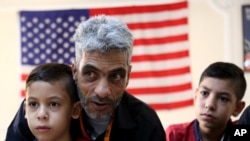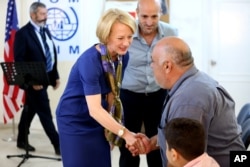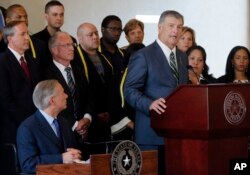The United States narrowly missed its refugee cap for the fiscal year, closing out 12 months of political turbulence over admissions policies just five people short of the administration's target of 85,000.
State Department data as of midnight October 1, the start of the 2017 fiscal year and the reset point for the government's financial calendar, is the closest the refugee program has come to meeting the presidentially established limit in 24 years.
Among the largest groups of refugees this year were more than 12,500 Syrians, following a self-declared goal by the administration last September to admit at least 10,000 people fleeing civil war and Islamic State violence there.
Democratic Republic of Congo and Myanmar were also among the top nationalities for resettled refugees.
Refugee Arrivals to the U.S. for FY2016
Dem. Rep. Congo: 16,370
Syria: 12,587
Myanmar: 12,347
Iraq: 9,880
Somalia: 9,020
Bhutan: 5,817
Iran: 3,750
Afghanistan: 2,737
Ukraine: 2,543
Refugee and resettlement officials told VOA last week that travel for some refugees who were scheduled to arrive by the end of September was postponed because the limit had been met. A State Department spokesperson did not confirm how many refugees were affected, but said that those who were delayed would be included in the coming fiscal year, which begins October 1.
“We understand that some clients may be held back these days and booked immediately in October. Thus, we expect no effect on clients,” said Bill Canny, who heads migration and refugee services for one of the country’s longest-serving resettlement agencies, the U.S. Conference of Catholic Bishops.
The Obama administration indicated in September that the ceiling for 2017 will rise to 110,000 refugees, as world leaders gathered at the United Nations in New York to discuss the migrant and refugee crisis; countries pledged to provide permanent placement to at least 360,000 refugees in the coming year, which would more than triple the available spots offered in 2015, the last year for which complete data is available. That increased number stills falls short of the projected need, which according to the U.N. refugee agency will top 1 million next year.
Since the late 1970s, the country has received more than 3.2 million refugees. The United States' modern refugee program, which began in 1980, has come increasingly close to the so-called "admissions ceiling" in recent years. In the last decade, however, nearly 129,000 available slots have gone unfilled.
In order to achieve the goal for Syrian arrivals this year, the Obama administration dedicated additional resources to the screening process in Jordan for refugees awaiting placement. Subsequently, thousands of Syrians were admitted from May to September.
During a brief news conference on September 27, Assistant Secretary of State for Population, Refugees, and Migration Anne C. Richard said that while the surge worked to expedite paperwork, “it should not become a routine way of our vetting process."
"We'd like to be able to do this in our existing routine operations throughout the year," she added.
Richard also said the number of cities where refugees are resettled in the U.S. is “likely to grow” in the coming months. Programs are already in place in roughly 350 cities in nearly every state.
“The United States can accept lots and lots and lots of refugees and provide a home for them,” she told reporters.
But not everyone wants to participate. For the last year, local, state and federal officials have fought over policy decisions and how the government is handling the higher numbers.
This month, Greg Abbott, governor of Texas - one of the leading states for refugee resettlement in recent years — announced his state was backing out of the federal refugee program. Refugees will continue to be placed in Texas, however, through an alternative program.
Kansas and New Jersey both withdrew in a similar manner after concerns over “security” related to refugee screening were raised, despite reassurances from administration officials about the vetting process, which includes investigations by federal law enforcement agencies, medical checks, and interviews.
Naomi Steinberg, director of Refugee Council USA, an advocacy group for 22 NGOs that work in refugee resettlement, said that what stood out for her after what she called "a difficult year of nasty political rhetoric" is that the U.S. continued a "proud tradition" of welcoming those fleeing persecution.
"We know that as loud as those anti-refugee voices are, that they are still in the minority,” said Steinberg.
Nike Ching contributed to this report from State Department.











